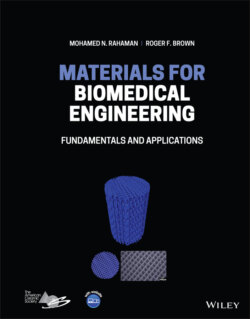Читать книгу Materials for Biomedical Engineering - Mohamed N. Rahaman - Страница 101
3.5.1 Microstructure of Dense Biomaterials
ОглавлениеThe simplest type of microstructure is a dense solid, such as a solid containing little or no porosity, composed essentially of a single phase as, for example, a Ti dental implant, an Al2O3 femoral head in a hip implant or a polymethyl methacrylate (PMMA) intraocular lens. As they are polycrystalline materials, pure metals and ceramics such as Ti and Al2O3, respectively, are composed of grains (Figure 3.23a). Assuming the use of proper production methods, resulting in a homogeneous microstructure free from flaws, the properties of the pure polycrystalline material are controlled mainly by the size of its grains. Finer grains, for example, often lead to better mechanical properties. Microstructure is not relevant to a nonporous glass or a nonporous amorphous polymer such as PMMA, for example, because when produced using proper methods, each consists of a homogeneous single phase without grains or boundaries.
Figure 3.23 Examples of microstructures of dense biomaterials. (a) Al2O3 showing grains and grain boundaries; (b) Ti6Al4V, a two‐phase (α + β) solid composed of α lamellae in β grains; (c) zirconia‐toughened alumina (ZTA) composed of zirconia (ZrO2) particles (grains) dispersed in a matrix of alumina (Al2O3) grains; (d) lithium disilicate glass‐ceramic composed of elongated lithium disilicate (Li2Si2O5) crystals in a glass matrix (removed by etching). The surface of the materials was etched thermally (a), (c), or chemically (b), (d) to better reveal the microstructure. (b)
Source From Peters et al. (2003)
; (d)
From Holand and Beall (2012).
At a higher level of complexity, we can consider a dense solid composed of more than one phase. The Ti alloy, Ti6Al4V, for example, used as fracture fixation plates, in hip implants and as dental implants, is typically composed of two crystalline phases at ordinary temperatures, termed an alpha (α) phase and a beta (β) phase. Depending on the production method and subsequent heat treatment, this alloy can show a variety of microstructures. Figure 3.23b shows one such microstructure, composed of nearly parallel α lamellae within large β grains. ZTA femoral heads used in hip implants are composed of a matrix of Al2O3 grains and a distribution of YSZ grains (Figure 3.23c). The volume fraction of the ZrO2 is often kept within a useful range, approximately 10–15%. For this composition, the optimal mechanical properties such as strength and resistance to fracture are achieved through production methods that give a fine grain size of the Al2O3 phase, less than a few micrometers, a finer grain size of the ZrO2 phase and a homogeneous distribution of the ZrO2 grains within the Al2O3 matrix.
Glass‐ceramics, produced by controlled thermal treatment of a parent glass, show a microstructure composed of crystals within a glass matrix. A glass‐ceramic typically has better properties, such as mechanical and thermal properties, than its parent glass. The volume fraction of the crystals in the majority of glass‐ceramics is in the range 30–70% but some glass‐ceramics have volume fractions outside this range. Lithium disilicate glass‐ceramics are widely used for dental restorations such as crowns and bridges. While these materials have excellent resistance to chemical degradation, optimal mechanical properties are achieved through a controlled thermal treatment of the parent glass to achieve a fine crystal size, a high volume fraction of crystals and a homogeneous distribution of the crystals within the glass matrix (Figure 3.23d).
In a nonporous form, semicrystalline polymers, such as PE are composed of a mixture of amorphous and crystalline phases (Figure 3.15b). The crystalline regions are referred to as crystallites. They are not called grains because they have a different structure from the grains in polycrystalline metals and ceramics. The properties of semicrystalline polymers often improve with a higher volume fraction and a homogeneous distribution of crystallites as, for example, in UHMWPE used as articulating bearings in hip and knee implants.
As polymers are weaker than bone, one way to improve their mechanical properties is to reinforce them with a strong solid phase, commonly a ceramic biomaterial in the form of particles or fibers, to form a composite (Chapter 12). Composites composed of hydroxyapatite particles dispersed in a PE matrix have been created for use as implants in healing bone defects (Bonfield et al. 1981). The hydroxyapatite particles enhance the elastic modulus of the PE, bringing it closer to that of bone. They also provide an additional benefit by imparting some degree of bioactivity to the implant and, thus, enhance its potential to form a stronger interfacial bond and integrate with host bone.
